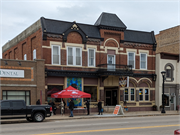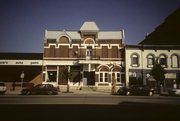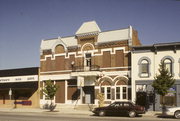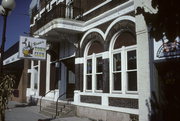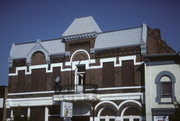Property Record
125 MAIN ST
Architecture and History Inventory
| Historic Name: | City Hotel |
|---|---|
| Other Name: | Town Club Restaurant |
| Contributing: | |
| Reference Number: | 81002 |
| Location (Address): | 125 MAIN ST |
|---|---|
| County: | Sauk |
| City: | Reedsburg |
| Township/Village: | |
| Unincorporated Community: | |
| Town: | |
| Range: | |
| Direction: | |
| Section: | |
| Quarter Section: | |
| Quarter/Quarter Section: |
| Year Built: | 1886 |
|---|---|
| Additions: | |
| Survey Date: | 1977 |
| Historic Use: | lodging-hotel |
| Architectural Style: | Second Empire |
| Structural System: | |
| Wall Material: | Brick |
| Architect: | |
| Other Buildings On Site: | |
| Demolished?: | No |
| Demolished Date: |
| National/State Register Listing Name: | City Hotel |
|---|---|
| National Register Listing Date: | 12/26/1984 |
| State Register Listing Date: | 1/1/1989 |
| National Register Multiple Property Name: | Multiple Resources of Reedsburg |
| Additional Information: | 6/1944, Adelman's and Churchill bought the building. Metal gable; corbel & dentil brickwork; semi-circular arched window heads; brick pilasters. The City Hotel is a two story brick Second Empire style hotel built in 1886 by the Reedsburg Building & Lumber Company. Constructed for $10,000, the hotel which measures 45' x 60', was praised in the "Reedsburg Free Press" for its "architectural beauty and massiveness" when it was completed in December, 1886. The rectangular hotel has a metal mansard roof underlined by large brick detils on the front (south) facade, with a metal hip roof gable near the center. The gable used to have a sign with "W. Roper" on it and the roof had metal cresting, now gone. Below the gable is corbel and dentil brickwork and brick forming a semi-circular arch. Stone trim ornaments the arch and forms a continuous irregular shaped window head and continuous horizontal sill for the second story windows. Below the brick arch is a door leading to a small front porch with an ornamental balustrade. Two elaborate decorative filligree brackets support the porch base. East of the second story porch are two 1/1 windows. The west section of the second story facade has four 1/1 windows, with the middle ones paired. Above the paired windows is a metal gablet that is also a part of the mansard roof. The gablet is decorated with a W-shaped incised design and the underside forms a semi-circular arch. Brick in a cross-hatched pattern delineates this arched area. Each edge of the front of the hotel is defined by brick pilasters decorated with stone scroll brackets at the top and second story levels. Stone bases and scored stone posts are also found on the first story facade. A cornice separates the two stories of the hotel. The east section of the first story hotel facade is delineated by two large brick semi-circular head arches with stone trim. Pairs of 1/1 rectangular windows are underneath the arches. West of the arches and directly below the second story porch is an umbrage entry with three doors. The central door facing south leads to the second story and the two doors facing east and west lead into each side of the first story. The west side of the first story has two large expanses of plate glass windows with paneled wood trim below them. Between the two windows, the area that was once a double door has been boarded over. The west side of the hotel has a small corbel brick dentil cornice. Five recessed brick panels with 2/2 windows and slightly arched brick heads originally on this side, but the windows have been bricked over. The hotel was not adjacent to any building on the west when built but a modern one story building abuts it on this side now. The east side has 2/2 brick arched head windows with wood frames on the second story, as does the back of the building, although some of the back first story has been bricked over. The stone foundation is visible on the back side. A concrete wash covers it on the front. A c. 1899 photo shows the hotel with steps from the west doors to the umbrage entry which are now gone. Otherwise the hotel has maintained a high degree of integrity on the exterior. When built in 1886 the hotel had about 17 rooms upstairs and a sitting room and parlor on the first story. There was a bar, reading room, three private rooms with kitchen and a dining room. In 1921, the hotel was sold and the dining room moved from the basement to where the bar had been on the west side of the first story. Sleeping room changes were also made. Today the west side is used as a restaurant and the east side used as a bar. They have undergone extensive remodeling. The hotel rooms are no longer used. There are 14 rooms and a bath and a half. A wooden stair bannister and some geometric wood designs near it appear to be original. Rooms are small with high ceilings and many have doors with transom windows above. Hallways are narrow and the remains of linoleum cover them. Rooms have been painted and papered over many times. The second story interior has maintained more of its integrity than the first story. The City Hotel is an architecturally significant example of Second Empire commercial design in Reedsburg and one of two nineteenth century hotels remaining in the city. The other hotel at 204 Main Street is included in the Main Street Commercial Historic District. The front or south facade of the City Hotel has retained a very high degree of integrity on both stories (when compared to the c. 1899 photo). The mansard roof and geometric white stone and red brick detailing highlight the facade. The small second story porch with its iron rail and brackets provides an aesthetically pleasing addition to the overall design. Because of its fine design and integrity, this building has local architectural significance. It was built by Reedsburg Building & Lumber Company, a firm begun by Edward M. Hackett, a locally prominent architect, in 1881. The firm had building contracts both inside and outside of Wisconsin and operated their own mill. William Roper was born in Germany in 1839 and came to the U.S. and Reedsburg c. 1868. He began hotel work as soon as he arrived in the village. Prior to 1886, Roper has a frame hotel on this site which was razed to make room for the new hotel in 1886. Around 1910 Roper retired after 35 years of running hotels. Roper's own house (c. 1908-1912) is at 136 Second Street, across the alley from the hotel. The hotel was sold in 1921. By 1944, the structure was known as the Reedsburg Hotel and a tavern and restaurant were operated as part of the hotel. A real estate office and hotel rooms were on the second story. The hotel operation closed in about 1966. Historically, the City Hotel is overshadowed by the larger and more prominent Hotel Stolte at 204 Main Street. |
|---|---|
| Bibliographic References: | (A) Centennial Souvenir. (B) Reedsburg Free Press, 1/14/1886; 4/15/1886; 6/10/1886; 12/23/1886; 3/3/1921; 4/21/1921. (C) Reedsburg Times, Souvenir edition, May 5, 1899. (D) Sanborn-Perris Maps. (E) Cole, Harry Ellsworth, A Standard History of Sauk County, Vol. I & II (Chicago and New York, The Lewis Publishing, Company, 1918). (F) Reedsburg Centennial Committee, Reedsburg Remembers (Historical Committee, Reedsburg Centennial, 1948). (G) Reedsburg Times-Press 8/2/1973. (H) Current owner of Town Club. |
| Wisconsin Architecture and History Inventory, State Historic Preservation Office, Wisconsin Historical Society, Madison, Wisconsin |

